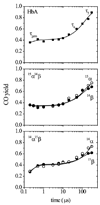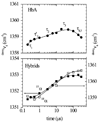Subunit-selective interrogation of CO recombination in carbonmonoxy hemoglobin by isotope-edited time-resolved resonance Raman spectroscopy
- PMID: 19245215
- PMCID: PMC2722936
- DOI: 10.1021/bi802190f
Subunit-selective interrogation of CO recombination in carbonmonoxy hemoglobin by isotope-edited time-resolved resonance Raman spectroscopy
Abstract
Hemoglobin (Hb) is an allosteric tetrameric protein made up of alphabeta heterodimers. The alpha and beta chains are similar, but are chemically and structurally distinct. To investigate dynamical differences between the chains, we have prepared tetramers in which the chains are isotopically distinguishable, via reconstitution with (15)N-heme. Ligand recombination and heme structural evolution, following HbCO dissociation, was monitored with chain selectivity by resonance Raman (RR) spectroscopy. For alpha but not for beta chains, the frequency of the nu(4) porphyrin breathing mode increased on the microsecond time scale. This increase is a manifestation of proximal tension in the Hb T-state, and its time course is parallel to the formation of T contacts, as determined previously by UVRR spectroscopy. Despite the localization of proximal constraint in the alpha chains, geminate recombination was found to be equally probable in the two chains, with yields of 39 +/- 2%. We discuss the possibility that this equivalence is coincidental, in the sense that it arises from the evolutionary pressure for cooperativity, or that it reflects mechanical coupling across the alphabeta interface, evidence for which has emerged from UVRR studies of site mutants.
Figures







Similar articles
-
Differential control of heme reactivity in alpha and beta subunits of hemoglobin: a combined Raman spectroscopic and computational study.J Am Chem Soc. 2014 Jul 23;136(29):10325-39. doi: 10.1021/ja503328a. Epub 2014 Jul 14. J Am Chem Soc. 2014. PMID: 24991732 Free PMC article.
-
Linking conformation change to hemoglobin activation via chain-selective time-resolved resonance Raman spectroscopy of protoheme/mesoheme hybrids.J Biol Inorg Chem. 2009 Jun;14(5):741-50. doi: 10.1007/s00775-009-0487-7. Epub 2009 Mar 14. J Biol Inorg Chem. 2009. PMID: 19288145 Free PMC article.
-
Intersubunit communication via changes in hemoglobin quaternary structures revealed by time-resolved resonance Raman spectroscopy: direct observation of the Perutz mechanism.J Phys Chem B. 2013 Oct 17;117(41):12461-8. doi: 10.1021/jp407735t. Epub 2013 Oct 9. J Phys Chem B. 2013. PMID: 24067234
-
Probing protein structure and dynamics with resonance Raman spectroscopy: cytochrome c peroxidase and hemoglobin.Biochemistry. 1990 May 15;29(19):4497-508. doi: 10.1021/bi00471a001. Biochemistry. 1990. PMID: 2164841 Review.
-
Resonance Raman spectroscopy as a probe of heme protein structure and dynamics.Adv Protein Chem. 1985;37:111-59. doi: 10.1016/s0065-3233(08)60064-9. Adv Protein Chem. 1985. PMID: 2998161 Review.
Cited by
-
Structural origin of cooperativity in human hemoglobin: a view from different roles of α and β subunits in the α2β2 tetramer.Biophys Rev. 2022 Apr 18;14(2):483-498. doi: 10.1007/s12551-022-00945-7. eCollection 2022 Apr. Biophys Rev. 2022. PMID: 35528033 Free PMC article. Review.
-
Differential control of heme reactivity in alpha and beta subunits of hemoglobin: a combined Raman spectroscopic and computational study.J Am Chem Soc. 2014 Jul 23;136(29):10325-39. doi: 10.1021/ja503328a. Epub 2014 Jul 14. J Am Chem Soc. 2014. PMID: 24991732 Free PMC article.
-
Heme reactivity is uncoupled from quaternary structure in gel-encapsulated hemoglobin: a resonance Raman spectroscopic study.J Am Chem Soc. 2012 Feb 22;134(7):3461-71. doi: 10.1021/ja210126j. Epub 2012 Feb 9. J Am Chem Soc. 2012. PMID: 22263778 Free PMC article.
-
Linking conformation change to hemoglobin activation via chain-selective time-resolved resonance Raman spectroscopy of protoheme/mesoheme hybrids.J Biol Inorg Chem. 2009 Jun;14(5):741-50. doi: 10.1007/s00775-009-0487-7. Epub 2009 Mar 14. J Biol Inorg Chem. 2009. PMID: 19288145 Free PMC article.
-
An Origin of Cooperative Oxygen Binding of Human Adult Hemoglobin: Different Roles of the α and β Subunits in the α2β2 Tetramer.PLoS One. 2015 Aug 5;10(8):e0135080. doi: 10.1371/journal.pone.0135080. eCollection 2015. PLoS One. 2015. PMID: 26244770 Free PMC article.
References
-
- Perutz MF. Mechanisms of Cooperativity and Allosteric Regulation in Proteins. Cambridge: Cambridge University Press; 1990. - PubMed
-
- Baldwin J, Chothia C. Hemoglobin - Structural-Changes Related to Ligand-Binding and Its Allosteric Mechanism. J. Mol. Biol. 1979;129 175-&. - PubMed
-
- Monod J, Wyman J, Changeux JP. On nature of allosteric transitions-A plausible model. J. Mol. Biol. 1965;12 88-&. - PubMed
-
- Perutz MF. Stereochemistry of cooperative effects in haemoglobin. Nature. 1970;228 726-&. - PubMed
Publication types
MeSH terms
Substances
Grants and funding
LinkOut - more resources
Full Text Sources
Research Materials

